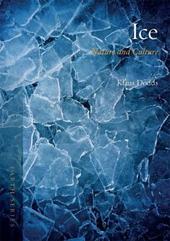
|
Ice: Nature and Culture
Paperback / softback
Main Details
| Title |
Ice: Nature and Culture
|
| Authors and Contributors |
By (author) Klaus Dodds
|
| Series | Earth |
|---|
| Physical Properties |
| Format:Paperback / softback | | Pages:224 | | Dimensions(mm): Height 210,Width 148 |
|
| Category/Genre | Popular science |
|---|
| ISBN/Barcode |
9781780239057
|
| Classifications | Dewey:551.31 |
|---|
| Audience | |
|---|
| Illustrations |
100 illustrations, 90 in colour
|
|
Publishing Details |
| Publisher |
Reaktion Books
|
| Imprint |
Reaktion Books
|
| Publication Date |
18 June 2018 |
| Publication Country |
United Kingdom
|
Description
Ice has played a prominent role in the history of the earth and its living communities for millennia. We have had fun with and on ice, battled over ice, imagined ice, struggled with ice and made money out of ice. It has transformed our relationship with food, and our engagement with ice has been captured in art, literature, popular film and television, as well as made manifest in sport and leisure. Our lakes, mountains and coastlines have been indelibly shaped by the advance and retreat of ice and snow. Beyond Planet Earth, ice can be found in meteors, planets and moons, and scientists think that ice-rich asteroids played a pivotal role in bringing water to Earth. In Ice: Nature and Culture Klaus Dodds provides a wide-ranging exploration of the cultural, natural and geopolitical history of ice, revealing how throughout history human communities have made sense of ice. For those who are intrigued about our relationship with ice, this book will provide an informative and thought-provoking guide.
Author Biography
Klaus Dodds is Professor of Geopolitics at Royal Holloway University of London and a Fellow of the Academy of Social Sciences. He has travelled and worked for many years in cold places, including the Arctic, Antarctica and mountainous areas of the world. Previous books include a co-authored volume, The Scramble for the Poles (2016).
Reviews"A broad look at all the ways that ice manifests itself and has influenced human lives and cultures across time. . . . [Dodds] is keenly aware of and concerned about what today's rapid melting will mean to our lives--physically, imaginatively, and in planetary health. Dodds concludes that, in future talks about ice, 'the tone is likely to be less focused on wonder and enjoyment and rather more tilted towards risk, hazard and a profound sense of loss.'"-- "Anchorage Daily News" "Transform[s] ice from frozen water into something remarkable: a substance always on the edge of our understanding. Once the instability of ice made it something to be claimed and conquered; today, however, this quality is inextricable from human interference. 'The tone of the conversation' about ice, Dodds writes, has been imbued with 'a profound sense of loss.' With the disappearance of ice comes the loss of cultures and languages that have evolved to express its complexity."-- "Times Literary Supplement" "A wide-ranging exploration of the cultural, natural, and geopolitical history of ice. It is very readable by all and forms part of a series of twenty four other books on natural phenomena written by various experts. . . . An easy and interesting read for anyone wanting to become an instant expert on all things ice."-- "Canadian Meteorological and Oceanic Society Bulletin" "Dodds is no stranger to the polar world and its glacial environment, having written widely on Antarctica and northern issues. He tackles the challenge admirably, selecting examples and situations that will invariably be found to be engaging, informative, and often surprising. This book has an unnerving, eclectic mix of aesthetics, folklore, and science. . . . This is an engaging read, almost a romp, through a world of ice and snow from a very different perspective to science-focused essays."--David Drewry "Arctic, Antarctic, and Alpine Research" "Dodds's addition to the Earth series provides an introduction to the many ways ice can be viewed and understood, and presents the frozen material in a way which is extremely accessible to a non-expert audience. Ice: Nature and Culture is abundantly illustrated, with the 95 illustrations that pepper the 211-page volume providing engaging visual material that supports the prose. The book draws on the history and significance of ice in areas as varied as geopolitics, scientific research, literature, and sport. Despite this eclectic amalgamation of subject matter, Dodds has deftly linked each chapter to the previous one, drawing together the ways in which ice has shaped our understanding of the world, and our relationship to this phenomenon. . . . Fantastically written and well-researched. . . . This is a great book for the lay polar enthusiast."-- "Polar Journal" "In Ice: Nature and Culture, Dodds gives the slippery and ephemeral material center stage to show how ice is not only fascinating but fundamental to human life itself. As a part of Reaktion Books' Earth series, Dodds's exploration of ice is both a literary and a visual pleasure to read, with beautiful color photographs throughout the book. . . . Wide-ranging."-- "Cultural Geographies" "In sum, the book is very interesting and relevant, posing topical and judicious questions. Well-researched, Ice is full of fascinating anecdotes, captivating stories, and well-chosen literary quotes. . . . A quality read that a curious reader will find rewarding."-- "Regards geopolitiques" "[Ice] explores our engagement with ice in art, literature, film and television, and in sport and leisure. Taking us on an enlightening journey to reveal how human communities have made sense of ice over the centuries, Dodds discusses man's exploration of ice and how indigenous peoples have adapted to live in frozen landscapes. . . . Well illustrated throughout, Ice is an informative and entertaining guide that sheds light on something we often take for granted."-- "Outdoor Photography"
|